From England to the Emerald Isle
Image: SeaWorld Parks
Opened in 1990 and 1991, respectively, copies of Questor quickly became fan favorites (and unexpectedly cutting-edge headliners) at both Busch Gardens parks in Virginia and Florida. Interestingly, the ride and its steampunk-inspired, fantastical adventure story felt somehow equally at home in both parks – a compliment to its adaptability given the two parks' seemingly opposed European and African settings.
After surprisingly short runs for the way they’ve become cult classics, the two Questor attractions closed in Virginia and Florida in 1995 and 1998, respectively, with each park earmarked to receive a new, modern, cutting-edge simulator more tailor-made for its specific setting.
In Tampa Bay, the ride (placed in the park’s Egypt section) became Akbar’s Adventure Tours, a screwball simulator through the sights of Egypt alongside Akbar, played by SNL alumnus Martin Short.
Image: Dave Bowman, Daily Press
In Williamsburg, it was rebuilt as a new simulator through the fables of King Arthur’s Challenge – admittedly, a better fit for the park’s medieval-stylized Hastings hamlet. An early (and we mean early) adopter of CGI animation, King Arthur’s Challenge didn’t quite live up to the hype, nor to the standard set by the fan-favorite Questor.
In fact, King Arthur's Challenge is one of the more obscure moments in the park's history, with practically no photographic evidence of the experience within and relatively few first-person accounts aside from rumblings of how terribly bad the ride was.
Luckily, just a few years after King Arthur’s disappointing debut, a more radical change occurred around it.
Images: SeaWorld Parks
When the park opened for the season in spring 2001, the medieval-stylized village of Hastings was no longer among its offerings. Over the winter, designers had crumbled the land’s castles, planted abundant greenery, re-styled exteriors, and re-cast the land’s theaters, shops, and restaurants to add the first new country to the park in over two decades: Ireland.
As the village of Killarney, this beautiful representation of Ireland gained an aura of mystic and magic – bubbling waterfalls with pots of gold behind the shimmering waves, leprechaun hideaways in gnarled trees, vine-covered arbors, ivy scaling the ancient castles that once appeared to be of Camelot.
Image: SeaWorld Parks
The new village of Killarney added a spot for Irish entertainment, pubs, and food while simultaneously requiring that the simulator inside the land change, too… The simulator's Arthurian exterior was remodeled as the landmark ruins of Muckinish Castle in County Clare, Ireland – a portal into a journey deep into the ancient moors of Ireland ruled by mythical creatures of old.
And now we’ve arrived at a ride most Virginian millennials will recognize, named for the winding road upon which the Ballyvaughan and Muckinish Castle ruins reside.
Corkscrew Hill
Image: Theme Park Insider
Corkscrew Hill may be remembered as a definitive attraction in the history of Busch Gardens. Guests would enter through the crumbled remains of an old Irish castle and queue in a long, almost-fantastical cavern adorned with ancient runes and symbols, emptying into two pre-show chambers set in the stark, lantern-lit ruins of the castle.
There, guests would meet old man McTavish via a pre-show sequence, offering, “If you’re the ones that’re wantin’ to see some magical beasties, I don’t recommend it highly. Mark me words ya buck-eyed tourists, there’s some nasty creatures round about the moors and glades of old Ireland…” Then, with a puff of magical dust, the audience would be “shrunk” and invited into an old cigar box to join the adventure.
Image: SeaWorld Parks
Corkscrew Hill was a wild, bucking, and altogether memorable journey through the folklore of Ireland, including encounters with goblins, witches, fairies, and flying horses – exactly the kind of “tales of the Old Country” that the park brought to life so expertly, the perfect fit for the park’s new Ireland. It was also a cutting edge display of the flexibility of simulators and how a simple reprogramming a new ride film could literally create a new ride. Even if Corkscrew Hill were nothing more than a motion platform in a box with a fixed screen ahead, the ride successfully “carried guests away” and became one of the park’s starring attractions.
As successful as Corkscrew Hill might've been, however, just a few months before its opening, the next leap forward in simulators debuted, and it was destined to change the course of Busch Gardens' Irish adventure.
Simulating Soarin’
When Disney’s California Adventure opened in February 2001, the relatively few visitors who did pass through the park’s entrance didn’t exactly leave with glowing reviews. In fact, the park meant to expand Disneyland into a multi-day, international resort ended up being a rare (and wild) miss in Disney Parks history. In fact, we encapsulated the surprising story of the park’s fall and rebirth in its own standalone feature, Declassified Disasters: Disney’s California Adventure.
Image: Disney
But while Disneyland’s second gate would eventually require well over $1 billion in fixes, it did feature at least one soaring success. Among the park’s few opening day attractions, the Lost Legend: Soarin’ Over California, was a gem. While Disney’s simulators had carried guests through the world of Star Wars and into the human bloodstream, Soarin’ Over California was different. Content with their ability to thrill, Imagineers instead opted to use the simulator to astound.
Image: Disney
Orchestral, graceful, and magnificent, Soarin’ placed riders in suspended hang-glider seats, ingeniously raising them into a domed screen and creating an epic, cinematic journey over the natural wonders of the Golden State, with jump-cuts perfectly cued to a (pardon the pun) soaring score and gentle effects like smell and wind creating a truly believable illusion.
Image: Disney
At once, ride manufacturers began cranking away to create their own aerial simulators, borrowing the basic tenants of Disney’s brilliant design and kicking off a generation of simulators across the world that follow the same basic premise, at theme parks and at roadside attractions and even shopping malls. But to the thinking of Busch Gardens’ designers and executives, they already had the ingredients they needed: A motion simulator and Europe. Corkscrew Hill closed at the end of the 2009 season.
Europe in the Air
Questor.
King Arthur’s Challenge.
Corkscrew Hill.
The simulator located in Busch Gardens Williamsburg’s Killarney village would receive its fourth facelift in 2009, re-opening the next year as Europe in the Air.
Image: SeaWorld Parks
While the previous inhabitants of this space might've had an air of mystery or mysticism, tied to the legends of England and Ireland, respectively, Europe in the Air is significantly more straightforward. In fact, Busch Gardens' spokespeople proudly trumpeted details about the ride, like a brand new projection system that would showcase the landmarks of Europe in a format "eight times clearer than HD."
But what most guests would notice about Europe in the Air isn't how much had changed from Corkscrew Hill, but rather, how much hadn't.
The ride was still entered via a crumbling Irish castle tower (albeit, now with a flashing red windsock beacon and a billboard advertising "Flights Departing NOW!"), and the queue continued to be a long hallway built as if of ancient, mystical stones. The only change? That fairytale-inspired queue now had distinctly-airport-style lights drilled into the stone walls... Hm...
That queue, too, continued to empty into a pre-show chamber clearly designed as an Irish stone castle, now simply painted sky blue rather than looking like stone. Those re-used pre-show rooms now featured Miles O'Skye, a red-bearded air traffic controller (our connection to the ride's Irish setting in the park?) eager to introduce us to the Slipstream 3000 – an "air sled" capable of instantly rocketing us from country to country to tour all the greatest landmarks of Europe.
"In fact, we offer a complete two-week holiday in mere minutes!" He cheers. "You're taking the Europe in the Air deluxe travel package, which is the best one! See, you're up in the air" (get it?) "flying over exciting destinations like the Blarney Castle in Ireland, Big Ben in England, the Eiffel Tower of France, up and over the German Alps and down the Italian coast of Sorento!"
We even recieve gee-whiz clearance to fly over the Roman Coliseum, much to O'Skye's surprise.
Image: Richard Bannister
Then, it's off to the Slipstream (familiar to those who rode Corkscrew Hill), which departs via Irish ruins and proceeds on a course across the continent to the tune of a triumphant orchestral score. And indeed, we soar over the Thames and past the London Eye, fly around the Arc du Triumph and the Eiffel Tower (albeit, conspicuously from the point-of-view of a car...), sail past Neuschwanstein Castle (famously, Walt Disney's inspiration for Disneyland's Sleeping Beauty Castle), cruise past the Coliseum, and dive into the trees for a landing back in Ireland. Between each scene, a slightly embarassing "screen saver" style animation of zooming through clouds connects the otherwise separate settings.
You can take a virtual tour through Europe in the Air on the Slipstream 3000 in this very... er... telling video of what it was like... (And watch those necks... Yikes! Not exactly smooth sailing.)
Now, sure, we couldn't expect Busch Gardens' re-use of Corkscrew Hill's simple, 1990 motion-base (er, "air sled," seen in action here) in a big industrial room with fans pointed at riders to match the brilliance and free-flight suspended sensation of Disney's Soarin', nor could the HD footage on the movie screen in front of you compete with Soarin's wrap-around OMNIMAX dome.
But Europe in the Air's hokey premise, odd theming, laughable transitions, and not-quite-Disney-quality ride experience were made all the worse by some of the most unusual motion programming of any simulator... As you can see in the video above, Europe in the Air shuffled, rattled, and banked, seemingly determined to make the most of the motion simulator base, oblivious that Soarin's simplicity and ease are its strengths! In Disney's ride, the motion is subtle enough as to meld into the experience; Europe in the Air's clumsier motion ellicited audible and synchronized groans from riders, the platform leaning far enough back and forward to literally leave the vehicle's shadow cast on the projection screen!
Coming off as more heavy-handed than aerial and graceful, the ride simply didn't approach the Soarin' standards it had obviously set out to match, and suddenly a ride ostensibly for the whole family became an uncomfortable and poorly-executed ride that could be skipped on return visits.
Image: Attraction Spot
Maybe you'd agree with most guests: Europe in the Air was a dud.
And on the last page, we'll explore what Busch Gardens did about it as we follow the ride to its fifth re-theming and explore the future (or lack thereof) for dark rides at SeaWorld Parks. Read on...

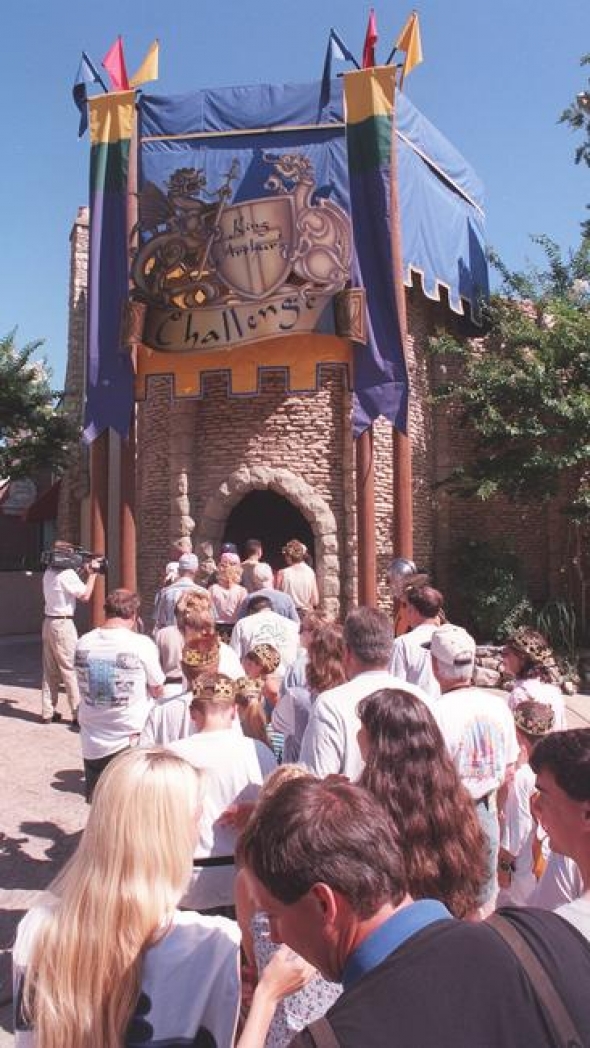
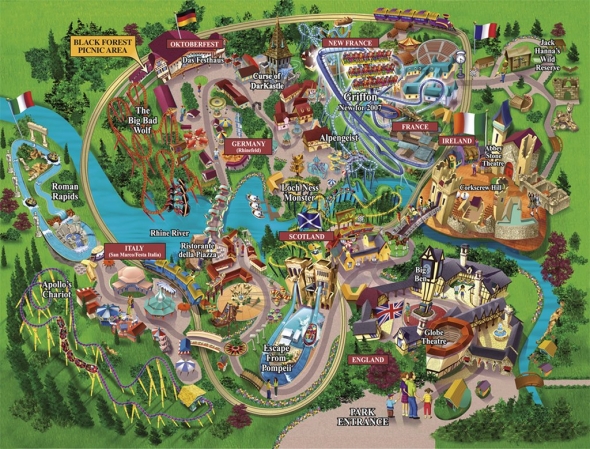
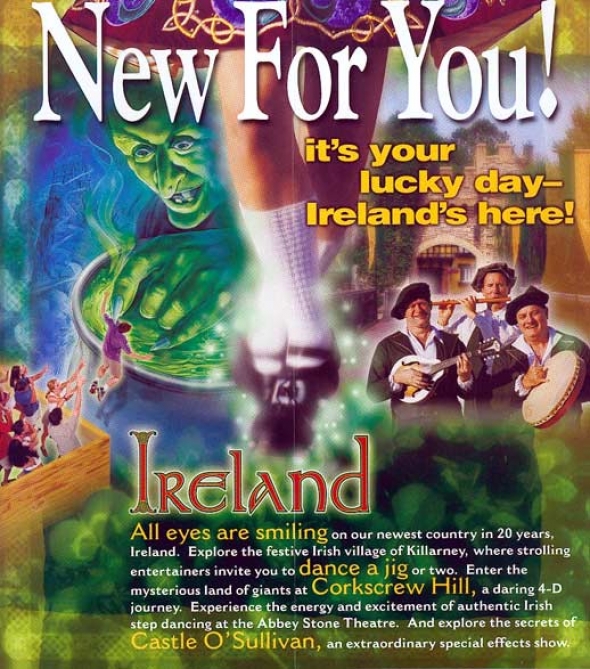
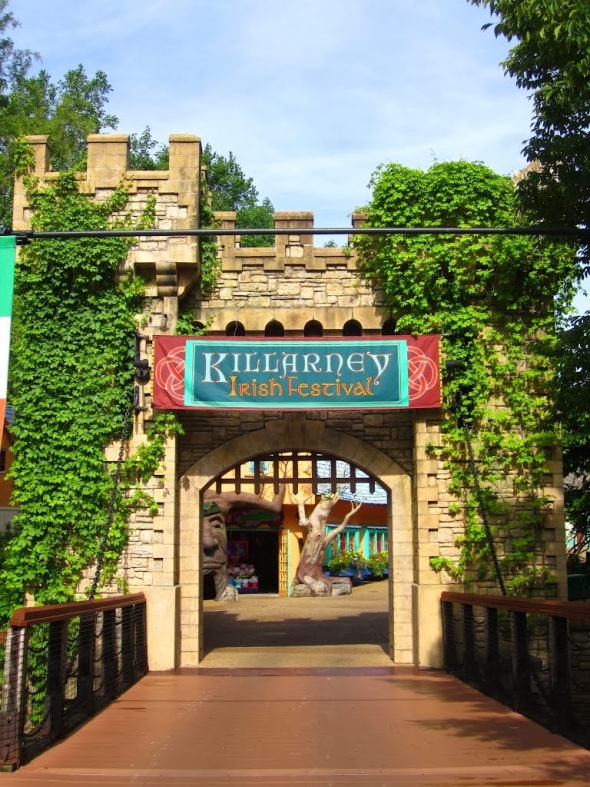
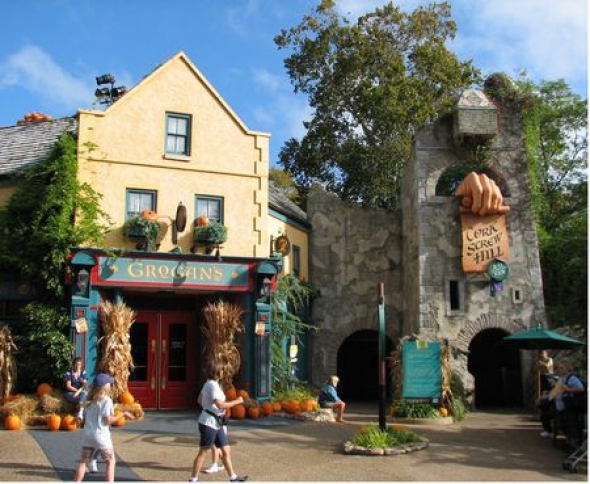
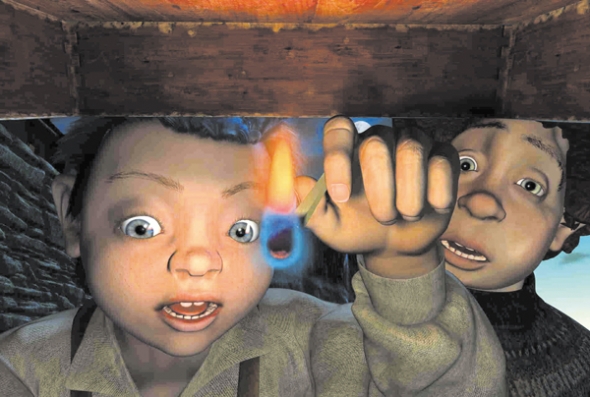

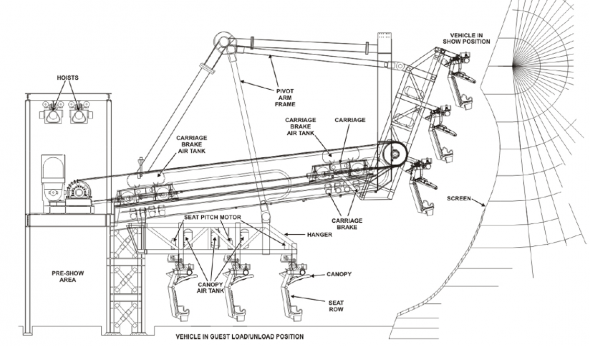
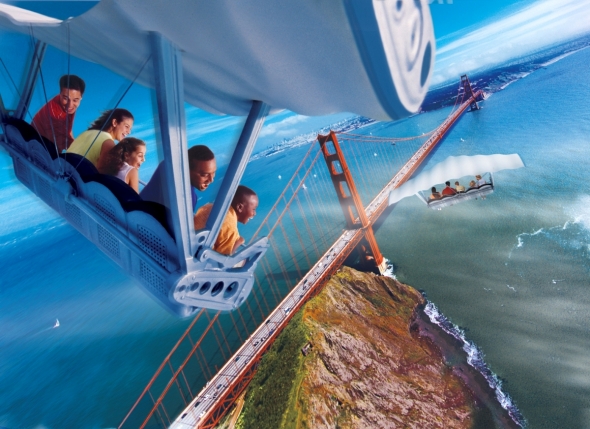
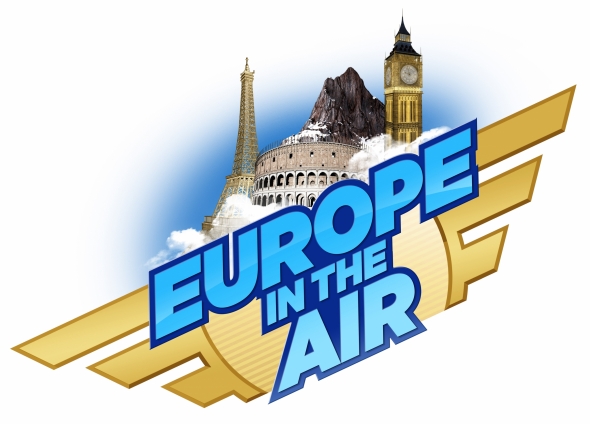
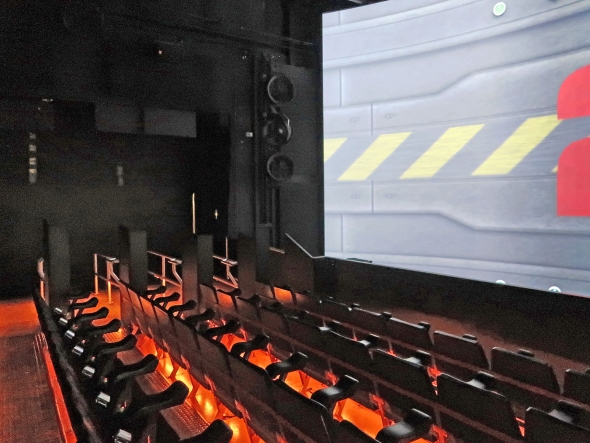
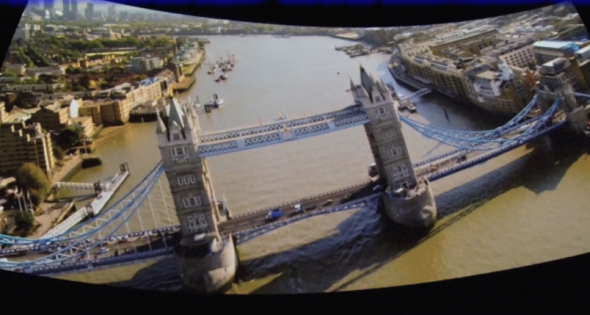

Add new comment